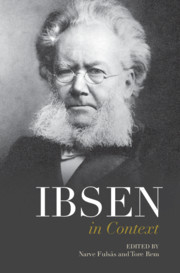Book contents
- Ibsen in Context
- Ibsen in Context
- Copyright page
- Contents
- Figures
- Contributors
- Preface
- Notes on the text
- Chronology
- Part I Life and Career
- Chapter 1 Early Years in Norway
- Chapter 2 From Theatre to Book
- Chapter 3 Bourgeois Drama
- Part II Culture and Society
- Part III Scandinavian Reception
- Part IV Internationalization
- Part V Afterlives
- Further Reading
- Index
Chapter 2 - From Theatre to Book
from Part I - Life and Career
Published online by Cambridge University Press: 23 April 2021
- Ibsen in Context
- Ibsen in Context
- Copyright page
- Contents
- Figures
- Contributors
- Preface
- Notes on the text
- Chronology
- Part I Life and Career
- Chapter 1 Early Years in Norway
- Chapter 2 From Theatre to Book
- Chapter 3 Bourgeois Drama
- Part II Culture and Society
- Part III Scandinavian Reception
- Part IV Internationalization
- Part V Afterlives
- Further Reading
- Index
Summary
This chapter covers Ibsen’s years in Rome (1864–8), Dresden (1868–75) and Munich (1875–80). Often presented as a voluntary ‘exile’, the move to Rome followed a general pattern of Norwegian authors and artists going abroad for training and studies. Ibsen’s prolonged stay had to do with his need to keep a distance from political pressures and conflicts in a small and transparent society. When he moved abroad, he also left the theatre as the institutional setting for his writings and transferred to the Danish publisher Gyldendal. Ibsen experienced his Scandinavian breakthrough in the book market with the verse dramas Brand (1866) and Peer Gynt (1867). Once again writing a play for performance, The League of Youth (1869), he ended up giving priority to the book. Throughout the rest of his career, Ibsen’s plays were issued as books before they were performed. The League of Youth became Ibsen’s breakthrough in the Scandinavian theatre, while at the same time initiating a rupture with the liberals in Norway. Ibsen’s conservatism became more outspoken throughout the 1870s, and, by the end of the decade, Ibsen had alienated himself from the emerging ‘Literary Left’, headed by Georg Brandes and Bjørnstjerne Bjørnson. Pillars of the Community (1877), however, seemed to signal a cautious reorientation.
Keywords
- Type
- Chapter
- Information
- Ibsen in Context , pp. 11 - 18Publisher: Cambridge University PressPrint publication year: 2021

